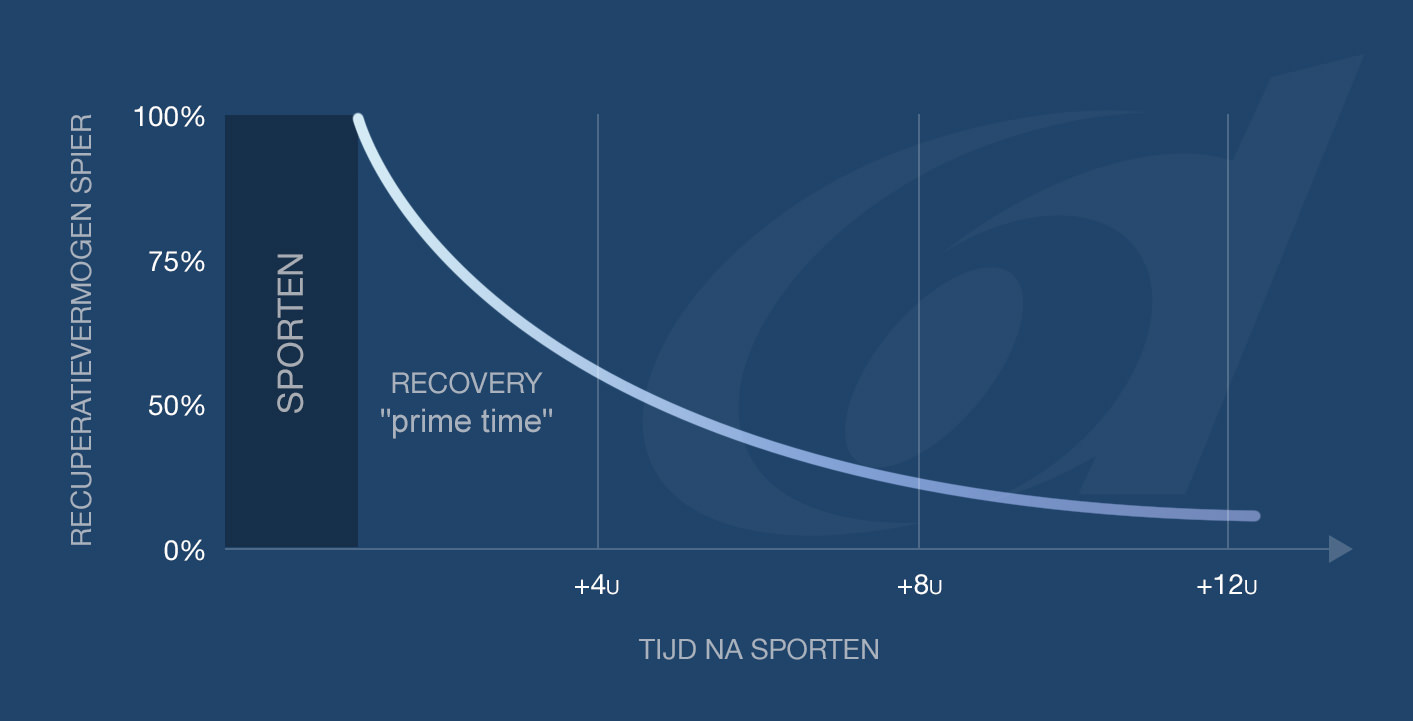Recovery after training and competition: just a protein shake or go for a full recovery shake?

The range of recovery products on the market is ample, which often makes it difficult to choose between different types of ‘recovery drinks’. One often assumes that the mentioning of ‘recovery’ or ‘recup’ on the label guides us to the right choice. However, this is a false assumption.
Before discussing the differential choices and versions of recovery drinks it is important to consider the specific role of their primary ingredients, notably proteins and carbohydrates.
Proteins after exercise deliver the amino acids needed for muscle repair as well as long term training adaptation. Indeed, performance gains due to training largely depend on the capacity for post exercise protein synthesis. This refers a.o. to the synthesis of muscular proteins involved in muscle mass accretion and force development, like mysosin heavy chains, but also to mitochondrial proteins (~enzymes) implicated in oxidative energy metabolism, or membrane proteins driving energy substrate transport in muscle cells during contractions. Micro-damage to muscle fibers is inherent to contractions. Such damage is important in the context of a ‘no pain, no gain’ training process’. Yet protein intake after exercise can facilitate muscle repair, and thereby stimulate long-term training adaptation. Therefore, irrespective of whether training targets muscle anabolism, or improvement of power, speed, or endurance, or a combination of these factors, protein intake following exercise is important. Therefore, proteins are the pivotal ingredient of any ‘recovery drink’.
Carbohydrates are the primary fuel in high-intensity endurance exercise. During prolonged maximal exercise events such as long-distance running or road cycling, or during prolonged intermittent exercise such as soccer or hockey, or high-intensity interval training sessions in endurance sports, muscle and liver carbohydrate stores are largely, if not entirely depleted. In such context, supplemental post exercise carbohydrate intake serves to rapidly refill thee carbohydrate stores. This is particularly important whenever exercise sessions are performed with short intervals (<48h) in between. But when recovery time is ample, normal carbohydrate intake (pasta, rice, bread, cereals, …) in meals will do the job, i.e. reload the energy. Power and speed training, but also low to moderate-intensity endurance training sessions relying mainly on fat metabolism, as a rule use less carbohydrates for muscular energy provision. Supplemental carbohydrate intake thus often is redundant in the latter exercise contexts.
Furthermore, consistent stimulation of post exercise muscle glycogen resynthesis is not a prerequisite of a well-designed endurance training program. In contrast, regular training at low initial glycogen levels might eventually improve performance in later competition at high initial glycogen level. Available findings indicate that ‘low glycogen training’ can stimulate muscular oxidative capacity, indeed. However, if not well managed such dietary strategy may also suppress training quality, or eventually even cause overreaching. Therefore, it is essential that the periodization of a ‘train low, perform high’ approach is supervised by an experienced sports nutritionist.
Apart from the composition of recovery drinks, adequate timing of ingestion also is pivotal. The potential for rapid muscular repair and recovery is highest immediately after exercise. As the time delay between cessation of exercise and supplement ingestion is increasing, the efficacy of the drink is decreasing and may not even exceed the effect of a normal meal delivering high-quality proteins and carbohydrates. Hence the ‘turbo effect’ on recovery requires the intake of a shake immediately after training or competition.

Figure 1: The potential of skeletal muscle to recover: prime time immediately after exercise.
The potential of skeletal muscles to rapidly recover via protein and glycogen synthesis is highest immediately after exercise. Within 3-4 hours recovery rate drops to ~50% of the initial level.
Recovery shakes
Aim - So-called ‘recovery shakes’ should contain a mixture of proteins and carbohydrates, and aim to stimulate muscle repair and long-term training adaptation, as well as simultaneously promote muscle and liver glycogen resynthesis. Importantly, compared with protein shakes (~100-120 kcal) recovery shakes contain much higher amount of energy (~300-400 kcal). Hence recovery shakes should only be used whenever carbohydrate stores are largely depleted by prolonged high-intensity exercise (see above). Otherwise they deliver redundant calories that conceivably may elevate body weight.
Composition and dose - An optimal recovery shake delivers 20 to 40g proteins in the form of whey protein isolate. Whey protein concentrate, casein, milk protein and certainly milk powder are inferior to whey protein isolate. In order to obtain a maximal degree of stimulation of muscle protein synthesis , a total leucine content of at least 3g is required. This corresponds to ~30g of high-quality whey protein isolate, except if the supplement is spiked with additional free leucine. Check the product label for total leucine content. Ingestion of 1g carbohydrates per kg body weight (bw) in conjunction with the aforementioned protein dose causes maximal stimulation of muscle glycogen resynthesis early after exercise. In the absence of concomitant protein intake, maximal stimulation of muscle glycogen resynthesis requires a 50% higher rate of carbohydrate intake (~1.5g per kg bw). Ideally the total carbohydrate dose contained in a recovery shake is composed of a mixture of glucose and fructose so as to simultaneously promote muscle (-> glucose) and liver (-> fructose) glycogen resynthesis.
Protein shakes
Aim - Protein shakes serve to promote muscle repair and training adaptation following exercise sessions causing just a minor or moderate extent of glycogen depletion (see above). In addition, protein supplementation is also crucial to support muscle mass maintenance during episodes of hypocaloric diet in conjunction with sustained exercise training. Rapid weight loss combined with strenuous training causes net muscle breakdown, indeed. Such effect initially may yield a positive perception while being on the scale, indeed, yet eventually is likely to negatively impact performance because of force ad power loss. Muscle mass degradation during weight loss can be negated by increasing daily protein intake rate to 2.0 – 2.5 g protein per kg bw.
Composition and dose - High-quality protein shakes contain only protein without carbohydates and marginal fraction of residual lactose. A protein bolus of 0.3g per kg body weight elicits maximal rate of muscle protein synthesis. For a 60kg person this implies a ~20g dose, increasing to ~30g in a 90 kg individual. Besides the total protein load, also the fraction of essential amino acids, especially leucine, plays an important role in protein quality. As indicated above, maximal stimulation of muscle protein synthesis by protein ingestion requires a leucine dose of at least 3g. The natural occurrence of leucine is highest in whey protein. In addition, whey protein is very rapidly absorbed which results in high blood leucine concentrations. These two features make whey protein to be first choice to stimulate muscle repair post exercise.
However, the sports nutrition market is being overwhelmed with a wide range of whey protein preparations and mixtures: whey protein isolate, whey protein concentrate, and whey protein hydrolysate. These whey protein sources refer to different protein quality. Whey protein concentrates contains ~80% whey protein at best, but in a worst case scenario this may be no more than xx%, the remaining fraction being mostly lactose and fat. Conversely, the whey protein fraction of an isolate is at least 90%, with the highest quality powders containing up to ~95% pure whey. Hydrolysates refer to whey protein isolates chemically cleaved into smaller protein chains (~petides) that are absorbed even faster than whey protein isolate. Finally, protein powders containing high fractions of full milk protein, or even milk powder, often are very cheap, but are ranked in the lowest quality range.
As indicted above, available research findings clearly indicate whey protein to be first choice to stimulate post exercise muscle protein synthesis. However, in the meantime evidence is also increasing that well-designed plant-based protein mixtures are pertinent to stimulate muscle protein synthesis. Vegan protein supplements containing protein from different plant sources (peas, soya, quinoa,…) allow to deliver a more pertinent mixtures of essential amino acids than single plant proteins, and hence are more potent to stimulate post exercise muscle repair. Nonetheless, in order to approach whey protein effectiveness a ~30% higher dose of plant protein is needed, which in turn also results in higher energy (kcal) intake.
Caseïne shakes
Aim – Caseïn is a slowly digestible protein, which resuts in slow absorption of the amino acids into the blood and resulting slow tranfer tot he muscles. Thus casein could be termed a ‘slow release’ protein, which makes the substrate particularly relevant as a protein source before bedrest. Indeed, it is well established that late evening casein intake can suppress overnight muscle protein breakdown, which eventually may facilitate muscle hypertrophy during episodes of resistance training specifically aiming at muscle mass accretion. Furthermore, during periods of strenuous training, alone or in combination with intensive competition, a late night casein shake or snack is likely to stimulate muscular repair and recovery. However, because of its slow absorption, casein should rather not be used as a protein supplement during ‘prime time’ early after training.
Composition - An adequate ‘night shake’ thus logically delivers the protein load in the form of casein. Available evidence indicate a total ~40g casein dose to be required in order to produce significant stimulation of muscle protein synthesis. Lower doses appear to be poorly effective.
Take home message
- Protein ingestion after a strenuous training or competition stimulates muscle repair and long-term training
- Post exercise carbohydrate intake stimulates muscle and liver glycogen resynthesis. Such effect is important after prolonged, continuous or intermittent, moderate to high-intensity exercise causing substantial glycogen depletion, especially when the rest interval between training sessions is short (<48u).
- Compared with protein shakes, recovery shakes delivering proteins + carbohydrates contain 3 to 4-fold more energy (kcal). Excess use of recovery shakes may elevate body weight and thereby impair performance.
- Whey protein is the first-choice protein to stimulate muscular recovery early after exercise. Conversely, casein is a ‘slow-release’ protein which is useful to prevent overnight muscle protein breakdown.
- Vegan shakes delivering a well-balanced mixture of proteins from different plant sources also can markedly stimulate muscle protein synthesis post exercise. Yet compared with whey protein, plant proteins require a ~30% higher dose.


